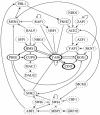Random Boolean network models and the yeast transcriptional network
- PMID: 14657375
- PMCID: PMC299805
- DOI: 10.1073/pnas.2036429100
Random Boolean network models and the yeast transcriptional network
Abstract
The recently measured yeast transcriptional network is analyzed in terms of simplified Boolean network models, with the aim of determining feasible rule structures, given the requirement of stable solutions of the generated Boolean networks. We find that, for ensembles of generated models, those with canalyzing Boolean rules are remarkably stable, whereas those with random Boolean rules are only marginally stable. Furthermore, substantial parts of the generated networks are frozen, in the sense that they reach the same state, regardless of initial state. Thus, our ensemble approach suggests that the yeast network shows highly ordered dynamics.
Figures




Similar articles
-
Boolean networks with biologically relevant rules show ordered behavior.Biosystems. 2007 Jul-Aug;90(1):40-7. doi: 10.1016/j.biosystems.2006.06.007. Epub 2006 Jun 29. Biosystems. 2007. PMID: 17188807
-
Anomalies in the transcriptional regulatory network of the yeast Saccharomyces cerevisiae.J Theor Biol. 2010 Apr 7;263(3):328-36. doi: 10.1016/j.jtbi.2009.12.008. Epub 2009 Dec 22. J Theor Biol. 2010. PMID: 20004671
-
Genetic networks with canalyzing Boolean rules are always stable.Proc Natl Acad Sci U S A. 2004 Dec 7;101(49):17102-7. doi: 10.1073/pnas.0407783101. Epub 2004 Nov 30. Proc Natl Acad Sci U S A. 2004. PMID: 15572453 Free PMC article.
-
Stability of Boolean networks with generalized canalizing rules.Phys Rev E Stat Nonlin Soft Matter Phys. 2012 Apr;85(4 Pt 2):046106. doi: 10.1103/PhysRevE.85.046106. Epub 2012 Apr 11. Phys Rev E Stat Nonlin Soft Matter Phys. 2012. PMID: 22680537
-
Boolean network models of cellular regulation: prospects and limitations.J R Soc Interface. 2008 Aug 6;5 Suppl 1(Suppl 1):S85-94. doi: 10.1098/rsif.2008.0132.focus. J R Soc Interface. 2008. PMID: 18508746 Free PMC article. Review.
Cited by
-
Properties of Boolean dynamics by node classification using feedback loops in a network.BMC Syst Biol. 2016 Aug 24;10(1):83. doi: 10.1186/s12918-016-0322-z. BMC Syst Biol. 2016. PMID: 27558408 Free PMC article.
-
Computing preimages of Boolean networks.BMC Bioinformatics. 2013;14 Suppl 10(Suppl 10):S4. doi: 10.1186/1471-2105-14-S10-S4. Epub 2013 Aug 12. BMC Bioinformatics. 2013. PMID: 24267277 Free PMC article. Clinical Trial.
-
Investigation on changes of modularity and robustness by edge-removal mutations in signaling networks.BMC Syst Biol. 2017 Dec 21;11(Suppl 7):125. doi: 10.1186/s12918-017-0505-2. BMC Syst Biol. 2017. PMID: 29322936 Free PMC article.
-
Evolution of control with learning classifier systems.Appl Netw Sci. 2018;3(1):30. doi: 10.1007/s41109-018-0088-x. Epub 2018 Aug 13. Appl Netw Sci. 2018. PMID: 30839802 Free PMC article.
-
A novel knowledge-driven systems biology approach for phenotype prediction upon genetic intervention.IEEE/ACM Trans Comput Biol Bioinform. 2011 Sep-Oct;8(5):1170-82. doi: 10.1109/TCBB.2011.18. IEEE/ACM Trans Comput Biol Bioinform. 2011. PMID: 21282866 Free PMC article.
References
-
- Lee, T. I., Rinaldi, N. J., Robert, F., Odom, D. T., Bar-Joseph, Z., Gerber, G. K., Hannett, N. M., Harbison, C. T., Thompson, C. M., Simon, I., et al. (2002) Science 298, 799–804. - PubMed
-
- Hughes, T. R., Marton, M. J., Jones, A. R., Roberts, C. J., Stoughton, R., Armour, C. D., Bennett, H. A., Coffey, E., Dai, H., He, Y. D., et al. (2000) Cell 102, 109–126. - PubMed
-
- Kauffman, S. A. (1993) Origins of Order: Self-Organization and Selection in Evolution (Oxford Univ. Press, Oxford).
-
- Derrida, B. & Weisbuch, G. (1986) J. Physique 47, 1297–1303.
-
- Harris, S. E., Sawhill, B. K., Wuensche, A. & Kauffman, S. (2002) Complexity 7, 23–40.
Publication types
MeSH terms
LinkOut - more resources
Full Text Sources
Other Literature Sources
Molecular Biology Databases

